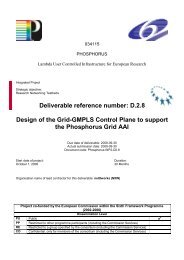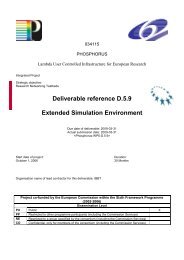Grid Job Routing Algorithms - Phosphorus
Grid Job Routing Algorithms - Phosphorus
Grid Job Routing Algorithms - Phosphorus
You also want an ePaper? Increase the reach of your titles
YUMPU automatically turns print PDFs into web optimized ePapers that Google loves.
<strong>Grid</strong> <strong>Job</strong> <strong>Routing</strong> <strong>Algorithms</strong>wavelengths). This coloring problem is known to be NP-complete (Nondeterministic Polynomial-complete)[Garey79] which means that, in general, it is computationally intractable, but there are many fast butapproximate (heuristic) algorithms for solving it. These algorithms try to optimize a properly selected costfunction and reduce the complexity of the RWA problem.An early work performed focusing on the RWA problem that initiated the study on the routing and wavelengthassignment in WDM optical networks is presented in [Banerjee96]. The objective of this work is to minimize thenumber of the required wavelengths for the routing of a fixed set of connection requests. RWA problem issegmented in smaller sub-problems which are solved independently of each other using efficient,approximating techniques. For the determination of the paths of each connection, a multi-commodity flowformulation is used in conjunction with randomized rounding techniques. The wavelength assignment part ofthe problem is carried out by the use of similar techniques that are adopted for the graph-coloring problem.In [Mokhtar98], the authors considered the RWA problem as a joint optimization problem and compareddifferent schemes for wavelength assignment (first fit, also studied in [Chlamtac92], random fit, maximumwavelength utilization [Bala95]). It was shown that the scheme which tries to first allocate the most usedwavelengths is more efficient. The criterion that was used for this purpose was the blocking performance of thenetwork. An analytical technique for the computation of the blocking probability is also presented for fixed andalternate routing. The wavelength assignment in fixed routing optical networks is also studied in [Subram97]. In[Hyytia00] and [HyytiaVirtamo00], the first fit policy is proven to be the simplest and the one with the leastcomplexity.When dealing with RWA as a joint optimization problem, it is considered in an obvious way as a special case ofthe integer multi-commodity flow problem [Vazirani01] with additional constraints, where each lightpathcorresponds to one flow unit, and is formulated as an integer linear program (ILP) [Papadimi98]. Typical RWAILP formulations were initially proposed in [Banerjee96] and [Stern99]; they contain all necessary and sufficienttypes of constraints for a general RWA scheme to be valid (flow conservation, distinct wavelength assignment,wavelength continuity) and aim to minimize the maximum congestion (in terms of lightpaths) arising on networklinks. The dual scheme is discussed in [Rama95], that tries to maximize the number of connections established,while the traffic characteristics are a priori given and the network resources (number of available wavelengths)are constrained. A few newer and more sophisticated RWA ILP formulations are presented in [Krishna01-Design, Krishna01-Algo, Saad04]. Despite that these formulations are able to produce exact RWA solutions,ILP is generally NP hard. In addition, such approaches become space intractable when dealing with largenetworks, since the amount of ILP variables and constraints grows exponentially with network size. Timereduction is achieved by relaxing the integrality constraints and solving the resulting linear program (LP). Sincefractional flows are not physically realizable in WDM optical networks (they are expressed in numbers oflightpaths), the LP solution must finally be converted to an integral one, that approximates the optimal value ofthe LP objective; that usually happens by utilizing appropriate rounding techniques. An RWA LP formulationrecently proposed in [Ozdaglar03] has been shown to produce optimal integer solutions (without rounding) for agreat fraction of RWA instances, despite the absence of integrality constraints. Space reduction is usuallyachieved by forcing lightpaths to be routed through a restricted subset of candidate paths, linear on the size ofthe network. This technique seems to decompose RWA; however, by selecting an appropriately big (butconstant) number of candidate paths to serve each lightpath, the space of RWA solutions constructed isexpected to be representatively large and contain an optimal RWA solution almost surely.Project:PHOSPHORUSDeliverable Number: D.5.3Date of Issue: 31/06/07EC Contract No.: 034115Document Code: <strong>Phosphorus</strong>-WP5-D5.321






